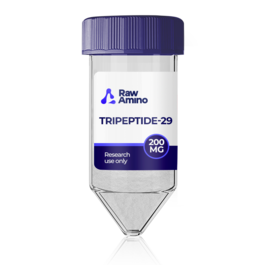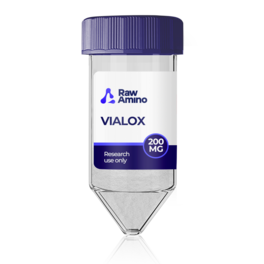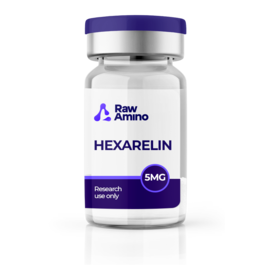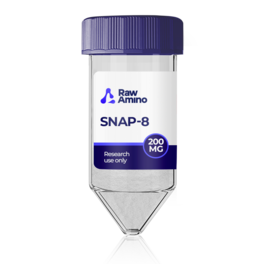
FOXO4-DRI – 10MG
$276.00
Discount per Quantity
| Quantity | Discount | Price |
|---|---|---|
| 5 - 8 | 5% | $262.20 |
| 9 + | 10% | $248.40 |
Scientific Overview of FOXO4-DRI
FOXO4-DRI is a synthetic peptide derived from the FOXO4 protein, designed with retro-inverso (D-amino acid) substitutions. This structural adjustment has been explored for its potential to retain certain functional properties of FOXO4 while exhibiting a longer stability profile in research settings. Interest in FOXO4-DRI has been driven by studies investigating cellular senescence, transcription factor signaling, and age-related cellular processes.
Alternative Names: Forkhead box protein O4, Proxofim, FOXO4a, AFX, AFX1, MLLT7
FOXO4-DRI Studies and Research Data
Investigations in Insulin-Linked Pathways
Research indicates that FOXO proteins may operate downstream of insulin and insulin-like growth factor signaling, with potential roles in cellular growth, oxidative stress regulation, and metabolic balance. Alterations in FOXO pathways have been associated in laboratory models with glucose dysregulation, lipid imbalance, and in some cases, enhanced susceptibility to metabolic disorders. FOXO4-DRI has been suggested in exploratory studies as a candidate for probing these signaling dynamics.
FOXO4-DRI Research on Cellular Senescence and Aging
FOXO4 has been observed to interact with the p53 protein, a critical regulator of apoptosis. In certain contexts, this interaction appears to suppress the apoptotic removal of senescent cells. FOXO4-DRI has been studied as a potential disruptor of this binding, thereby allowing p53 to engage with pro-apoptotic pathways. In laboratory models, this has been linked to reduced accumulation of senescent cells and possible improvement in tissue function. Some mouse studies have reported indications of tissue regeneration and extended physical performance, though such findings remain under continued investigation.
FOXO4-DRI Studies on Heart-Related Mechanisms
Declining proteasome activity over time has been associated with protein accumulation and impaired cardiac tissue maintenance. Research has proposed that FOXO signaling may contribute to enhanced proteasomal and autophagy activity. Experimental observations suggest FOXO4-DRI could be relevant for exploring how proteasomal function might be preserved in cardiac tissues, with implications for studying age-associated heart conditions.
Research in Neurodegeneration Models
Experimental findings have associated FOXO protein function with the regulation of proteasomal activity, a pathway that may be impaired in conditions such as Huntington’s, Alzheimer’s, and Parkinson’s diseases. Reduced proteasome clearance has been linked to neuronal dysfunction. FOXO4-DRI and related constructs have been studied as tools to better understand these mechanisms, potentially offering models to examine how FOXO-related signaling interacts with neurodegenerative processes.
Exploration of Selectivity in FOXO4-DRI Activity
One area of interest is FOXO4-DRI’s suggested selectivity in modulating FOXO4-p53 binding. Research proposes that while it may influence senescence-associated pathways, it appears to preserve FOXO4’s antioxidative transcriptional activity. Antioxidant enzymes such as catalase, glutathione peroxidase, and MnSOD remain vital to cellular defense, and FOXO4-DRI has been considered a tool to examine senescence while maintaining these protective systems.
Conclusion
FOXO4-DRI has drawn scientific attention for its potential use in investigating cellular senescence, transcription factor signaling, and age-related processes. Laboratory studies have highlighted possible roles in apoptosis regulation, insulin signaling, proteasome activity, and neurodegenerative disease models. While findings suggest multiple areas of research relevance, further study is required to clarify its mechanisms and applications.
References
- Murakami T, Inagaki N, Kondoh H. Cellular Senescence in Diabetes Mellitus: Distinct Senotherapeutic Strategies for Adipose Tissue and Pancreatic β Cells. Front Endocrinol (Lausanne). 2022;13:869414.
- Lee S, Dong HH. FoxO integration of insulin signaling with glucose and lipid metabolism. J Endocrinol. 2017;233(2):R67–R79.
- Zhu M, Zhang QJ, Wang L, Li H, Liu ZP. FoxO4 inhibits atherosclerosis through its function in bone marrow derived cells. Atherosclerosis. 2011;219(2):492-8.
- Huang Y, He Y, Makarcyzk MJ, Lin H. Senolytic Peptide FOXO4-DRI Selectively Removes Senescent Cells From in vitro Expanded Human Chondrocytes. Front Bioeng Biotechnol. 2021;9:677576.
- Bourgeois B, Madl T. Regulation of cellular senescence via the FOXO4-p53 axis. FEBS Lett. 2018;592(12):2083-2097.
- Doti N, Mardirossian M, Sandomenico A, Ruvo M, Caporale A. Recent Applications of Retro-Inverso Peptides. Int J Mol Sci. 2021;22(16):8677.
- Baar MP, Brandt RMC, Putavet DA, et al. Targeted Apoptosis of Senescent Cells Restores Tissue Homeostasis in Response to Chemotoxicity and Aging. Cell. 2017;169(1):132-147.e16.
Disclaimer:
The products mentioned are intended solely for laboratory research and in-vitro experimentation. They are not approved for human or animal use of any kind. All details provided are for educational purposes only. By purchasing from this site, you agree to comply with our Terms and Conditions.
Only logged in customers may leave a review.





Reviews
There are no reviews yet.